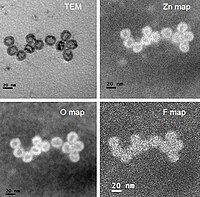
Photo from wikipedia
Abstract A new synthetic approach has been developed to prepareα-Fe2O3@TiO2 core-shell nanostructures at ambient conditions (e.g., in water, ≤100 °C). This approach shows a few unique features, including: short reaction time… Click to show full abstract
Abstract A new synthetic approach has been developed to prepareα-Fe2O3@TiO2 core-shell nanostructures at ambient conditions (e.g., in water, ≤100 °C). This approach shows a few unique features, including: short reaction time (a few minutes) for forming core-shell nanostructures, no requirement of high temperature calcinations for generating TiO2 (e.g., at 80–100 °C), tunable TiO2 shell thickness, high yield and good reproducibility. The experimental results show that the α-Fe2O3@TiO2 core-shell nanostructures exhibit enhanced photocatalytic activity compared to the pure TiO2 and pure Fe2O3 in degradation of organic dye molecules with solar light irradiation. This could be attributed to the large surface area of TiO2 nanoparticles for maximum harvesting light adsorption, enhanced visible light absorption, and the effective charge separation at the heterojunction of α-Fe2O3 and TiO2. The findings may open a new strategy to synthesize TiO2-based photocatalysts with enhanced efficiency for environmental remediation applications.
Journal Title: Powder Technology
Year Published: 2018
Link to full text (if available)
Share on Social Media: Sign Up to like & get
recommendations!